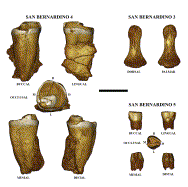Stefano Benazzi, Marco Peresani, Sahra Talamo , Qiaomei Fu , Marcello A. Mannino , Michael P. Richards , Jean-Jacques Hublin
Source - http://www.sciencedirect.com/science/article/pii/S004724841300239X
Abstract
In 1986–1987, three human remains were unearthed from macro-unit II of San Bernardino Cave (Berici Hills, Veneto, Italy), a deposit containing a late Mousterian lithic assemblage. The human remains (a distal phalanx, a lower right third molar and a lower right second deciduous incisor) do not show diagnostic morphological features that could be used to determine whether they were from Homo neanderthalensis orHomo sapiens. Despite being of small size, and thus more similar to recent H. sapiens, the specimens were attributed to Neandertals, primarily because they were found in Mousterian layers. We carried out a taxonomic reassessment of the lower right third molar (LRM3; San Bernardino 4) using digital morphometric analysis of the root, ancient DNA analysis, carbon and nitrogen isotope analyses, and direct accelerator mass spectrometry (AMS) radiocarbon dating of dentine collagen. Mitochondrial DNA analysis and root morphology show that the molar belongs to a modern human and not to a Neandertal. Carbon 14 (14C) dating of the molar attributes it to the end of the Middle Ages (1420–1480 cal AD, 2 sigma). Carbon and nitrogen isotope analyses suggest that the individual in question had a diet similar to that of Medieval Italians. These results show that the molar, as well as the other two human remains, belong to recent H. sapiens and were introduced in the Mousterian levels post-depositionally.

Figure 1.
Three-dimensional digital models of San Bernardino 3 (distal phalanx), San Bernardino 4 (lower right third molar, LRM3), and San Bernardino 5 (lower right second deciduous incisor, Rdi2). The black bar in the figure is equivalent to 1 cm. B, buccal; D, distal; L, lingual; M, mesial.

Figure 2.
Basic steps involved in measuring the root of San Bernardino 4 LRM3: the root was separated from the crown based on the best-fit plane computed at the cervical line (cervical plane). An additional plane, parallel to the cervical plane and passing through the centre of the bifurcational zone was created (plane at bifurcation). Based on these two planes, the root and the pulp were separated in the following parts: root stem volume, root apex volume, coronal pulp volume and root pulp volume. The cervical plane also allows the identification of the cervical plane area.